F1 Faces Major Sponsorship Shift: Rolex Rumored to Withdraw
Jul.10 - Formula 1 could be set to lose one of its biggest global sponsors, according to the Swiss newspaper Blick. The deal with the well-known luxury Swiss watchmaker Rolex,..
| Name | Jackie Stewart |
| Country | |
| Height | 1.73 meter / 5 feet 8 inch |
| Place of Birth | Milton |
| Date of Birth | Jun 11th 1939 - 85 years old |
| Season Entries | 9 |
| Car Number | 6 |
| First Race | 1965 South African F1 GP |
| Last Race | 1973 USA F1 GP |
| First Pole | 1969 Monaco F1 GP |
| Last Pole | 1973 German F1 GP |
| First Win | 1965 Italian F1 GP |
| Last Win | 1973 German F1 GP |
| First Win from Pole | 1969 French F1 GP |
| Last Win from Pole | 1973 German F1 GP |
| First Hat-trick | 1969 French F1 GP |
| Last Hat-trick | 1972 USA F1 GP |
| F1 Teams History | BRM (1965-1967) Matra (1968-1969) March (1970) Tyrrell (1970-1973) |
Jackie Stewart F1 Stats | |
| Drivers' Titles | 3 |
| Grand Prix Entries | 100 |
| Grand Prix Starts | 100 |
| Total Points | 360.00 |
| Avg. Points per GP | 3.60 |
| Grand Prix Wins | 27 (27,0%) |
| Wins from pole | 8 (8,0%) |
| Pole Positions | 17 (17,0%) |
| Front Row Starts | 33 (33,0%) |
| Avg. GP Grid | 4.5 |
| GP Podiums | 43 (43,0%) |
| GP Fastest Laps | 15 (15,0%) |
| GP Points Finish | 57 (57,0%) |
| Avg. GP Position | 3.0 |
| Hat-tricks | 4 (4,0%) |
| GP Retirements | 39 (39,0%) |
| GP DNF's | 36 (36,0%) |
| Total GP Laps | 5.225 |
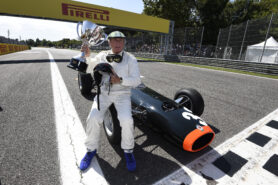
Jackie Stewart and his BRM in which he won the Italian GP 50 years ago! in 1965
Jackie Stewart was Britain's first driver to win three F1 World Championships in history.
Born on the 11th of June of 1939 in Milton, Scotland, Sir John Young Stewart grew up to be one of the greatest pioneers of Formula 1 racing and the key individual who pushed the sport to become as safe as it is today. A true gentleman, businessman and family man, he also won three Formula 1 World Drivers’ Championships and is among the elite drivers in the history of racing.
Stewart grew up inside his father’s car garage, which was the family’s livelihood. His mother was not a fan of racing, but his father Bob was a rider and his brother Jimmy went on to try his hand at competing in motorsport. Jackie became a talented clay pigeon shooter and was part of Scotland’s shooting team, he even tried to earn a place to compete in the 1960 Olympics.
At age 15, Stewart stopped attending school and was working as a mechanic in his father’s garage. In 1961, he entered the motorsport world after testing a variety of cars for Barry Siler —a client of his father’s garage— at Oulton Park, where he tested a Jaguar in 1962 and proved to have speed.
After his experience with Filer, Stewart signed with Ecuri Ecosse and competed at Goodwood with high success, driving a Tojeiro and a Cooper T49. He won more than 10 races in 1963 and earned a test with Ken Tyrrell at Goodwood in 1964. He drove a Formula Three car in the test and went on to be faster than Bruce McLaren on the same car —Cooper T72— and on the same day, which, of course, prompted Tyrrell to offer him a racing seat.
In the 1964 Formula Three season, Stewart won his debut race by more than 40 seconds and at the end of the year won the title with solid drives.
He declined various offers for a Formula 1 seat but eventually competed in a non-championship event in December 1964, the Rand Grand Prix in South Africa. Although he was set to make his official debut with BRM in 1965, he competed for Lotus —which was his F2 team after he tested the F1 Lotus 33— in the non-championship event. Stewart started from Pole, but a driveshaft issue forced him to retire from the race.
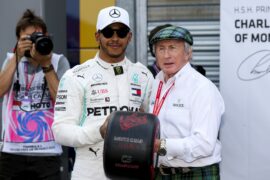
Sir Jackie Stewart gives Lewis Hamilton his the Pirelli trophy for his 85th pole in Monaco (2019)
In his first World Championship race, at South Africa, Stewart started 11th and finished sixth, scoring one point. In his second race, at Monaco, he earned his first podium with a third place in a race won by his teammate Graham Hill.
After three second places in the following five races, Stewart took his maiden victory after a great drive. He started third in the race and took advantage of a fuel pump issue in Jim Clark’s Lotus. Stewart won ahead of Hill in a BRM 1-2.
Also, he competed in the 1965 24 Hours of Le Mans with Hill as his teammate and both finished second in their class driving a Rover-BRM.
He finished his first year third in the WDC behind Clark and his teammate Hill. In the following two seasons with BRM, Stewart could finish only five of the 19 races he started in 1966 and 1967. At the 1966 Belgian Grand Prix, Stewart suffered a crash which forced him to miss the following race at France and opened his eyes on the safety issue that a deadly Formula 1 was facing at that time. His car was upside down and he was rescued by Hill and Bob Bondurant, who were both kicked out of the race track due to the heavy rain.
A win in the inaugural race of the 1966 season at the Monaco Grand Prix was the only success he enjoyed between 1966 and 1967 in Formula 1, However, he won the Tasman Series title in 1966 ahead of Hill and Clark and won Rookie of the Year honours in the 1966 Indy 500, where his LolaT90 failed when he was enjoying a big lead with eight laps remaining.
In 1967 he entered the Indianapolis 500 again, but an engine issue cut his race short and he did not lead any of the 168 laps he completed.
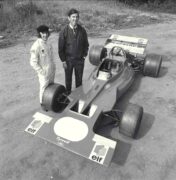
Tyrrell 001 with Jackie Stewart & Ken Tyrrell (1970)
For the 1968 Formula 1 Grand Prix, a move to Ken Tyrrell’s Matra International would put Stewart in a position to charge for the World Championship. The first three GPs of the year were bad for Stewart, as he had to retire from the first race at South Africa and missed the following couple of races at Spain and Monaco due to an injury while driving in F2.
He came back fiercely and went on to win three of the following eight races. He won at Zandvoort, Nürburgring and Watkins Glen to enter the final race at Mexico with the chance to take the title away from Graham Hill and Denny Hulme, who was the reigning champion at the time.
Despite his efforts and the speed of the Matra MS10, Stewart had to settle for second in the championship behind his former teammate Hill. He needed a victory at Mexico to seal the deal, but engine trouble put an end to his charge. In fact, the Cosworth engine proved to be a liability in two of the last four races of 1968, as Stewart had retired from the 1968 Italian Grand Prix due to engine-related problems.
For 1969, Stewart came in as a force and won the first race, held at South Africa, driving the MS10. Then, the MS80 was introduced and Stewart became almost impossible to beat. He won at Spain, the Netherlands, France, Great Britain and finished second at the Nürburgring, which put him and Matra on the verge of clinching both titles in the 1969 Italian Grand Prix.
A win in an incredible 1969 Italian Grand Prix at Monza, where the leader finished 0.19 seconds ahead of the fourth-placed car, meant the first title for Stewart and Matra. At the same circuit where he won his first-ever Grand Prix, the Scottish clinched his first World Championship. In 1969, Stewart led at least one lap in every race.
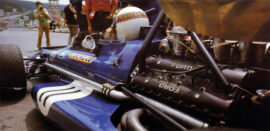
Jacky Stewart on the grid in his March-Ford F1 car at Spa-Francorchamps (1970)
For the 1970 season, conflict of interests arrived at the World Championship team, as Matra could not go forward with Ford engines due to contractual agreements with Chrysler. The situation prompted Tyrrell to create his own car, but the team had to race a March 701 in the first 10 races of 1970 as the Tyrrell 001 was introduced in the late stage of the season.
A win at Spain and three other podiums in the 10 races with the March chassis were not enough to allow the reigning champion Stewart to fight for the title. In the first race with the Tyrrell 001, Stewart qualified on Pole at Canada, but could not finish the race due to reliability issues which extended to the other two races to end the season. Stewart finished fifth in 1970 with only one victory.
The 1971 season and the introduction of the Tyrrell 003 in the second race of the year, at Spain, saw Stewart dominate with incredible skills. After a podium in the first race behind the wheel of the Tyrrell 001, Stewart won five of the following six GPs with the 003 equipped with the V8 Cosworth engine.
Stewart’s second title was sealed at the 1971 Austrian Grand Prix, where he had to retire due to mechanical issues. Again with three races to spare, no driver would be able to catch Stewart’s tally of points by the end of the year, summarising just how dominant he was.
In 1971, he also finished third in the Can-Am series.
In 1972, it was Emerson Fittipaldi who dominated, although not in the same fashion as Stewart did in 1969 and 1971. Stewart had a tough 1972. He missed the race at Belgium in 1972 due to health issues and was not able to compete for the title driving his Tyrrell-Ford. However, he managed to take second place in the WDC from Hulme by winning the last two races of the year at Canada and the USA.
Previous victories at Argentina and France proved his speed was still there, but his car had unreliability issues at certain races and he could not overcome that.
For a superstar such as Stewart, retirement from F1 was close, and it was the 1973 season which would mark his last dance in the pinnacle of motorsport. Stewart was undoubtedly the biggest name in racing at the time, not only for his racing but for his actions off the track. He helped the sport become a little bit safer during his time and cemented the foundation for what F1 is today regarding safety. Also, he helped F1 become the social phenomenon it is with his TV appearances and his contribution as a promoter for F1.
Of course, if he was on his way out, he had to go out as a great champion.
Stewart started 1973 with a third place in Argentina, second in Brazil, a victory in South Africa and a DNF at Spain due to brake failure. After winning one of the first four races, he trailed Lotus’ Fittipaldi by 12 points —a win was worth nine points—.
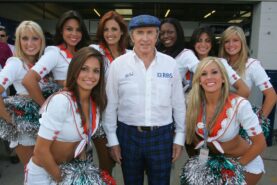
Jackie Stewart with grid girls
From that point on, Stewart went on to win four of the next eight races. Stewart outscored Fittipaldi 47 to 11 on that eight-race stretch, which practically secured the title for the Scottish driver. In the 1973 Monaco Grand Prix, Stewart tied the all-time record of 25 wins, previously set by Jim Clark in 1968. Then, he went on to break the record with his success at Zandvoort —in the race where Roger Williamson tragically passed away—.
In the 1973 Italian Grand Prix —again at Monza, where all the F1 success started for Stewart—, it became full circle for Stewart as an astonishing recovery saw him go from 20th to fourth to secure his third championship with two races left.
In what would be the 100th and last race of Stewart’s career, the 1973 United States Grand Prix, the weekend became dark after the tragic death of François Cevert—Stewart’s teammate— in qualifying.
Tyrrell withdrew from the race and Stewart did not start his 100th Grand Prix as his friend sadly died.
Stewart Grand Prix brought the great champion —who held the all-time victories record until 1987— back to Formula 1 in 1997. The team entered 49 races between 1997 and 1999 and could not consistently compete with the bigger brands, but five podiums and a great victory were not bad.
The win in the 1999 European Grand Prix by Johnny Herbert meant more for Jackie than the 27 he achieved driving.
Three driving championships and possibly three other championships regarding safety —full-face helmets, seatbelts and an efficient medical team at the races— are part of a legacy that must not be forgotten.
“When I arrived in Grand Prix, racing so-called precautions and safety measures were diabolical”.
“I would have been a much more popular World Champion if I always said what people wanted to hear. I might have been dead, but definitely more popular.”
| 1965 | 1966 | 1967 | 1968 | 1969 | 1970 | 1971 | 1972 | 1973 |
|---|---|---|---|---|---|---|---|---|
| 3rd | 7th | 9th | 2nd | 1st | 6th | 1st | 2nd | 1st |
| Year | Team | Engine | GP | 1st | 2nd | 3rd | Pod | Pole | Laps | FL | Avg Pts | Points |
|---|---|---|---|---|---|---|---|---|---|---|---|---|
| 1973 |
| Ford | 15 | 5 | 2 | 1 | 8 | 3 | 884 | 1 | 4.73 | 71 |
| 1972 |
| Ford | 11 | 4 | 1 | 0 | 5 | 2 | 607 | 4 | 4.09 | 45 |
| 1971 |
|
Cosworth Ford | 11 | 6 | 1 | 0 | 7 | 6 | 607 | 3 | 5.64 | 62 |
| 1970 |
|
Ford Ford | 13 | 1 | 2 | 1 | 4 | 4 | 652 | 0 | 1.92 | 25 |
| 1969 |
| Ford | 11 | 6 | 1 | 0 | 7 | 2 | 618 | 5 | 5.73 | 63 |
| 1968 |
| Ford | 10 | 3 | 0 | 1 | 4 | 0 | 608 | 2 | 3.60 | 36 |
| 1967 |
| BRM | 11 | 0 | 1 | 1 | 2 | 0 | 405 | 0 | 0.91 | 10 |
| 1966 |
| BRM | 8 | 1 | 0 | 0 | 1 | 0 | 304 | 0 | 1.75 | 14 |
| 1965 |
| BRM | 10 | 1 | 3 | 1 | 5 | 0 | 540 | 0 | 3.40 | 34 |
| 1st | 27 Times |
| 2nd | 11 Times |
| 3rd | 5 Times |
| 4th | 6 Times |
| 5th | 5 Times |
| 6th | 3 Times |
| 7th | 2 Times |
| 9th | 1 Time |
| 10th | 1 Time |
| 11th | 2 Times |
| DNF | 36 Times |
| WD | 1 Time |
| Year | Race | No | Team | Engine | Grid | Pos | Retired | Pts | |
|---|---|---|---|---|---|---|---|---|---|
| 17 | 1973 | 1973 German F1 GP | 5 | Tyrrell | Ford | 1 | 1 | 9 | |
| 16 | 1973 | 1973 French F1 GP | 5 | Tyrrell | Ford | 1 | 4 | 3 | |
| 15 | 1973 | 1973 Monaco F1 GP | 5 | Tyrrell | Ford | 1 | 1 | 9 | |
| 14 | 1972 | 1972 USA F1 GP | 1 | Tyrrell | Ford | 1 | 1 | 9 | |
| 13 | 1972 | 1972 South African F1 GP | 1 | Tyrrell | Ford | 1 | DNF | Gearbox | 0 |
| 12 | 1971 | 1971 USA F1 GP | 8 | Tyrrell | Ford | 1 | 5 | 2 | |
| 11 | 1971 | 1971 Canadian F1 GP | 11 | Tyrrell | Ford | 1 | 1 | 9 | |
| 10 | 1971 | 1971 German F1 GP | 2 | Tyrrell | Ford | 1 | 1 | 9 | |
| 9 | 1971 | 1971 French F1 GP | 11 | Tyrrell | Ford | 1 | 1 | 9 | |
| 8 | 1971 | 1971 Monaco F1 GP | 11 | Tyrrell | Ford | 1 | 1 | 9 | |
| 7 | 1971 | 1971 South African F1 GP | 9 | Tyrrell | Cosworth | 1 | 2 | 6 | |
| 6 | 1970 | 1970 Canadian F1 GP | 3 | Tyrrell | Ford | 1 | DNF | Axle | 0 |
| 5 | 1970 | 1970 Belgian F1 GP | 11 | March | Ford | 1 | DNF | Engine | 0 |
| 4 | 1970 | 1970 Monaco F1 GP | 21 | March | Ford | 1 | DNF | Engine | 0 |
| 3 | 1970 | 1970 South African F1 GP | 1 | March | Ford | 1 | 3 | 4 | |
| 2 | 1969 | 1969 French F1 GP | 2 | Matra | Ford | 1 | 1 | 9 | |
| 1 | 1969 | 1969 Monaco F1 GP | 7 | Matra | Ford | 1 | DNF | Halfshaft | 0 |
Jul.10 - Formula 1 could be set to lose one of its biggest global sponsors, according to the Swiss newspaper Blick. The deal with the well-known luxury Swiss watchmaker Rolex,..
It is a well-known fact that racing drivers from the United Kingdom are more than just successful. We can see countless names on the list. The popular author Jack Reeve helps..
Oct.21 - Sir Jackie Stewart has vowed to follow the career of French driver Pierre Gasly more closely. The F1 legend and triple world champion, 84, sat down with Gasly on the..
Aug.31 - Former triple world champion and F1 legend Sir Jackie Stewart doubts Lewis Hamilton will ever win another world championship. He told the German magazine Sport Bild that..
Jul.11 - Formula 1 teams and officials have appealed to the British government to make their lives easier due to the consequences of 'Brexit'. France's Auto Hebdo reports that a..
Delve into the incredible career and life of one of Formula 1's greatest drivers, Sir Jackie Stewart, in this fascinating episode of the Beyond the Grid podcast. Known as the..
Table of Contents 1. The Cars and Constructors of the 1970s 2. The Drivers of the 1970s 3. The Races and Seasons of the 1970s 4. Conclusion The 1970s is considered by many to be a..
Remastered clip of the 1969 British Grand Prix at Silverstone. This is a 60FPS video | Pole Position: Jochen Rindt / Lotus 49B (No.2) | Race Winner: Jackie Stewart / Matra MS80..
60fps upscaled clip of the 1973 Monaco Grand Prix (onboard footage begins at 2:33). Onboard footage of Nanni Galli in Iso-Marlboro was probably shot during a practice session. The..
Sep.9 - F1 legend Sir Jackie Stewart thinks it's time a new world champion is crowned. "It's always nice to see a young challenger who can attack the leader," the 82-year-old, a..
Read more Jackie Stewart News »
Latest Comments